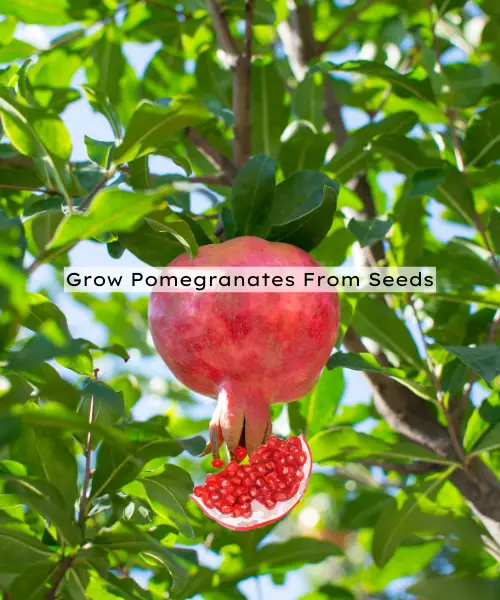There’s nothing quite like the taste of a fresh, juicy pomegranate.
The sweet ruby-red arils, bursting with flavor, make a refreshing snack or addition to salads, drinks, and desserts.
If you love pomegranates, you may be interested in growing your pomegranate tree from seed.
While it takes patience, growing pomegranates from seed allows you to cultivate new, unique varieties.
In this step-by-step blog post, we will cover everything you need to know about how to grow pomegranate trees from seeds at home.
We will also talk about when to plant pomegranate seeds, the requirements for successful germination, transplanting seedlings, ongoing pomegranate tree care, and how to harvest the fruits when they’re ready.
Read on to learn how to enjoy homegrown pomegranates from the very first seed!

What Are Pomegranates?
Pomegranates, also known as Punica granatum, are a fruit-bearing deciduous shrub or small tree in the Lythraceae family. Native to regions from the Middle East to Northern India, pomegranates have been cultivated for thousands of years. The name “pomegranate” derives from the Medieval Latin words “pomum,” meaning apple, and “granatum,” meaning seeded.
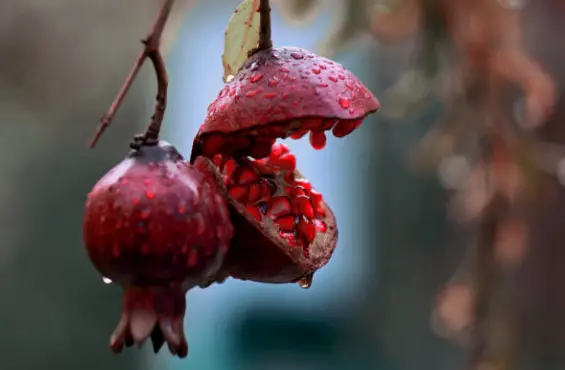
Pomegranate trees can grow 12–20 feet tall but are often kept pruned to 6–10 feet for easier harvesting. The glossy green leaves are narrow and lance-shaped. The brilliant orange-red flowers have a distinctive cup shape. After pollination, the flowers develop into the recognizable pomegranate fruit—a reddish-brown leathery exterior filled with juicy ruby-red arils packed in a white spongy membrane.
When to Plant Pomegranate Seeds
The ideal time to plant pomegranate seeds is in early spring, after the last frost has passed. Pomegranate seeds need warm soil temperatures of at least 65–70 °F to germinate well. In warm climates where winter temperatures stay above freezing, you can plant pomegranate seeds as early as late winter (January–February). In colder zones, it’s best to wait until late spring (April–May) when the ground has had a chance to warm up sufficiently.
Preparing Pomegranate Seeds for Planting
Once you have fresh pomegranate seeds, there are a few steps to take before planting:
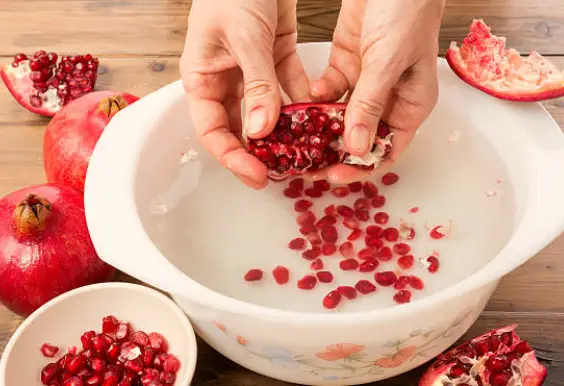
1. Remove seeds from pomegranate fruit
Carefully break open a ripe pomegranate fruit and separate out the juicy arils containing the seeds. Pick out and discard any bits of white membrane still attached.
2. Extract seeds from arils
You can either suck or squeeze the seed out of each individual aril, or put the arils in a blender with some water and pulse briefly to release the seeds. Strain out the seeds and discard the pulp.
3. Clean seeds
Rinse the seeds well under cool water to remove any remaining pomegranate flesh or juice, which can promote fungal growth. Spread the seeds out on a paper towel to air dry completely before planting.
4. Optionally cold stratify seeds
Some growers recommend cold stratifying the seeds for 3–4 weeks in the refrigerator before planting to help break dormancy. This step isn’t strictly necessary but can improve germination rates.
How to Germinate Pomegranate Seeds
Once your seeds are prepared, you’re ready to plant! Here are two methods for germinating pomegranate seeds:
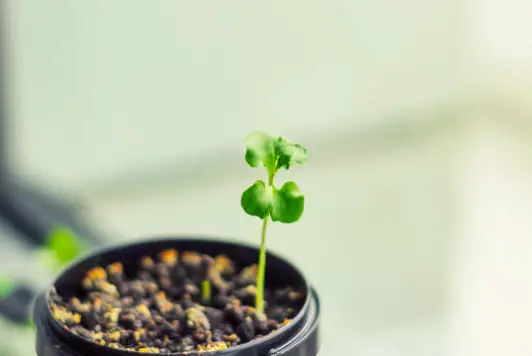
Germinate Pomegranate Seeds
Planting Directly in the potting mix:
1. Fill a seed tray or small pots with well-draining seed starting mix or potting soil
2. Plant pomegranate seeds 1/2 inch deep, spaced a few inches apart
3. Water thoroughly and place in a warm (70–80°F) sunny location
4. Keep soil moist but not soaked until germination, which can take 3–8 weeks
Germinating in Seed-Starting Trays:
1. Moisten a seed-starting tray with a sterile seed-starting mix
2. Place pomegranate seeds about 1 inch apart on the surface
3. Cover seeds with 1/4 inch of seed starting mix
4. Place tray in a warm (70–80°F) location until seeds sprout
5. Once sprouted, remove cover and place under bright lights or move to a sunny window
In both cases, patience is key. Pomegranate seeds can be slow and erratic to germinate. Keep providing consistently warm, moist conditions and the seeds will eventually sprout.
Transplanting Pomegranate Seedlings
Once your pomegranate seedlings have reached 4-6 inches tall with their first set of true leaves, it’s time to transplant. Here’s how:
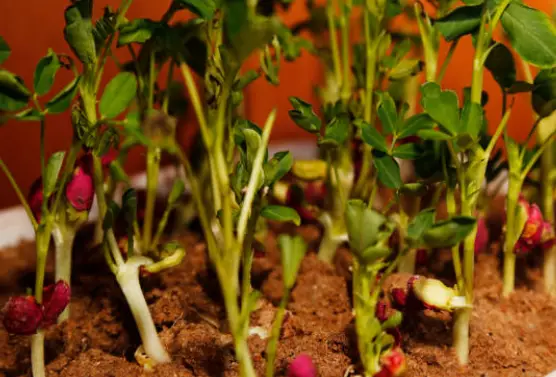
1. Prepare containers
Transplant seedlings into individual 6-inch pots with drainage holes filled with potting mix or a blend of compost, peat moss, perlite or sand.
2. Dig holes for transplants
Make a hole in each pot slightly wider and deeper than each seedling’s root mass.
3. Carefully transplant
Gently remove seedlings from the seed tray, minimizing root disturbance, and place in prepared holes.
4. Back-fill with soil
Fill in around the roots with potting mix, firming the soil gently. Leave the top inch or two of the stem exposed.
5. Water thoroughly
Water each seedling thoroughly after transplanting to settle the soil.
Caring for Pomegranate Trees
Pomegranate seedlings need consistent care to thrive in the first year or two before transplanting outdoors. Here are some basic care tips:

Sunlight
Pomegranate trees need at least 6–8 hours of direct sunlight each day. Gradually introduce outdoor sunlight if starting indoors.
Water
Keep soil consistently moist but not waterlogged. Deep soaking is better than frequent light sprinkles.
Fertilizer
Use a balanced liquid fertilizer every 2-3 weeks during the growing season.
Pruning
Remove any dead or damaged branches on young pomegranate trees. Prune yearly to shape.
Hardening Off / Overwintering
Before transplanting, slowly introduce outdoor conditions by setting potted plants outside during the day and bringing back in at night for 1-2 weeks. In cold regions, young trees need protection from freezing temperatures.
Transplanting Pomegranate Trees Outdoors
Around 12–18 months after germination, once the trunk has reached roughly pencil thickness, pomegranate trees are ready to transplant into the ground. Choose your transplant site carefully.
1. Sunlight
Full sun (6–8 hours of direct light)
2. Soil
Well-draining, slightly acidic soil amended with compost or manure. Pomegranates tolerate a wide range of soil conditions but prefer loamy soils.
3. Spacing
Plant pomegranate trees 15-20 feet apart, farther from buildings or walls, to accommodate future growth
Dig a hole wider than the rootball but no deeper than the roots to avoid burying too deep. Backfill with native soil and compost or manure mix. Stake young trees to establish straight trunks. Water thoroughly after transplanting.
Ongoing Pomegranate Tree Care
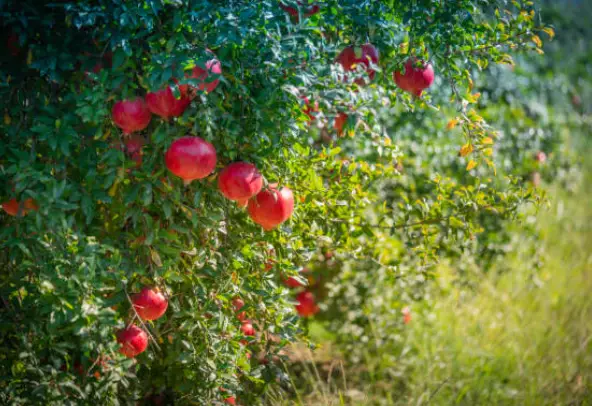
With the right care, pomegranate trees are long-lived and productive for 15-20 years or longer. Here is what established pomegranate trees need:
Watering
Mature pomegranates have moderate drought tolerance once established, but do best with deep watering every 7–14 days during the hot season. Allow soil to partially dry between waterings.
Fertilizing
Feed pomegranate trees in early spring and again in early summer with balanced fertilizer or compost/manure. Too much nitrogen promotes foliage over fruiting.
Pruning
Thin out crowded interior branches annually in late winter to maintain shape and air flow. Head back rangy branches and remove any dead wood.
Cold Protection
In cold climates (zones 7 and below), pomegranate trees will need winter protection like wrapping or a burlap shelter when temperatures dip below freezing.
Pests & Disease
Monitor for common pomegranate issues like leaf-footed plant bugs, whiteflies, fruit borers, and foliar diseases. Use insecticidal soap, neem oil, or other approved treatments as needed.
Harvesting Pomegranates
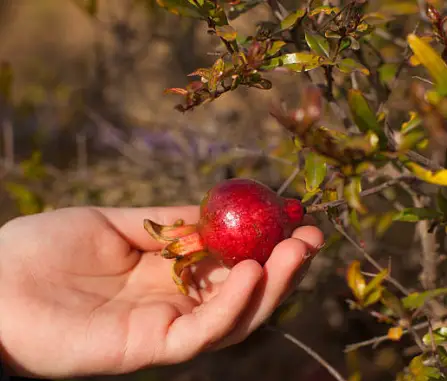
Harvesting Pomegranates
The wait from seed to fruit may take a few years, but it is well worth it for that first homegrown pomegranate harvest! Pomegranate trees typically begin bearing fruit 2-3 years after germination, with fuller yields by years 4–5.
Pomegranates are ready for picking when the exterior color changes from bright red/yellow to a deeper red or reddish-brown hue. The fruit should feel heavy for its size, with a metallic calyx at the base. You may also notice some cracking at the crown near the stem.
Wear gloves when harvesting pomegranates to avoid staining your hands from the dark red juice inside. Use pruners or scissors to snip the fruits off the branches rather than pulling. Be gentle to avoid bruising or splitting the leathery skin.
After harvesting, remove any dried floral remnants from the pomegranate crown and rinse off any dust or debris. Store pomegranates at room temperature for up to 1-2 months or in the refrigerator for even longer storage of 4-6 months.
Troubleshooting Common Pomegranate Growing Problems
While pomegranates are generally easy to grow once established, there are a few common problems to watch out for:
Failure to Germinate
If pomegranate seeds fail to sprout after 2-3 months, the most likely causes are overly dry soil conditions or planted seeds that were non-viable. Ensure consistent moisture and only plant fresh, plump seeds.
Seedlings Damping Off
Dark, spotted stems that cause seedlings to collapse and die is a sign of damping off disease, caused by fungal pathogens in overly wet soil. Allow potting mix to dry between waterings.
Poor Fruiting
Trees with vigorous foliage growth but little to no fruit may be getting too much nitrogen fertilizer or insufficient sunlight. Cut back on nitrogen and ensure 6–8 hours of direct sun daily.
Fruit Drop or Splitting
Drought stress, pest damage, or rapidly changing temperatures can cause immature fruits to drop prematurely or split open on the tree. Maintain consistent watering and pest control.
Alternate Bearing Years
Like many fruit trees, pomegranates can fall into a pattern of heavy yields every other year rather than annual crops. Prune after heavy years to reduce overcropping.
Sunscald Damage
In hot climates, fruits on the western exposure can become sunburned if not sheltered with adequate foliage cover. Protect fruits with shade cloth if needed.
With some patience and the right climate for their growing needs, pomegranate trees can be very rewarding fruit plants to grow from seed in the home garden or landscape!
Wrapping Up: Enjoying Homegrown Pomegranates
There’s a certain pride and sense of accomplishment that comes from enjoying fruits you grew from seed yourself. From planting that first tiny pomegranate seed to waiting years for the first ripe red fruits to appear on your tree, homegrown pomegranates are well worth the effort.
Now that you know the ins and outs of how to grow pomegranates from seed, you can start your own seeds today. In just a few years, you’ll be able to reach out and pluck fresh pomegranates from your own tree whenever the craving strikes. Enjoy the juicy, ruby-red arils bursting with sweet-tart pomegranate flavor, the ultimate reward for your patience and care as a seed-grown pomegranate farmer!
Whether you eat your homegrown pomegranates out of hand or incorporate the jewel-toned arils into recipes and drinks, you’ll appreciate the fruits of your labor so much more. So gather up some fresh pomegranate seeds and follow the steps outlined here to take on the rewarding journey of growing your very own pomegranate trees from seed.

